Entering the season, the hope for the New Orleans Pelicans was that they would be a frisky team because of their length on the front court to wreak havoc on opposing offenses and their abundance of offensive playmakers. Through nine games thus far, most of that has rung true, leading to a respectable 5-4 record after Monday night’s tough loss in Portland.
For all of the recent hype about New Orleans’ offensive firepower (they scored 139 freaking points against Minnesota!), their defensive will need to be relied upon when things get down to the nitty gritty. As of Nov. 17, the Pelicans are just about league average (16th to be specific) when it comes to defensive efficiency rating, according to nba.com.
Defensive efficiency measures the amount of points a team gives up per 100 possessions and is regarded as one of the most important statistical measures of a team’s defense.
A league average defense that is paired with a top tier offense (New Orleans is remarkably third in offensive efficiency) usually leads teams to great places, but I can’t help but feel that the Pelicans are underachieving on the defensive side of things.
One of the reasons why the defense may be subpar thus far is the simple fact that Anthony Davis is not affecting as many shots as he did last season. Sure, Davis is blocking a ridiculous 4.0 shots per game, but opponents are shooting a cool 60.9 percent on shots within six feet of the basket with Davis defending, per NBA.com’s SportVU player tracking data.
That number gives Davis a net defensive field goal percentage on shots within six feet of the basket of 9.0, per NBA.com’s SportVU player tracking data.
Net defensive field goal percentage is the difference between the normal field goal percentage of a shooter throughout the season and the field goal percentage when the defensive player is guarding the shooter. A good defensive player will have a negative number because they are holding their opponent under the league average.
To put Davis’ alarmingly high number into perspective, last season he had a net defensive field goal percentage of minus-5.8 on those very same types of shots and Roy Hibbert (the most elite of the elite rim protectors) posts a number of -14.0.
More from Hoops Habit
- The 5 most dominant NBA players who never won a championship
- 7 Players the Miami Heat might replace Herro with by the trade deadline
- Meet Cooper Flagg: The best American prospect since LeBron James
- Are the Miami Heat laying the groundwork for their next super team?
- Sophomore Jump: 5 second-year NBA players bound to breakout
Now, given Davis’ freakish ability and a wingspan that gives Jay Bilas wet dreams, that number should shift back to where it was last season as the 82-game grind wears on. However, it is still something worth monitoring moving forward.
An important defensive dynamic in today’s NBA game is how a team chooses to defend the pick and roll. The Chicago Bulls for instance, are notoriously known for playing the pick and roll “conservatively” by having their big man hang back behind the pick and beg the ball handler to take a contested mid-range jump shot.
On the other hand, teams like the LeBron James-era Miami Heat were known to aggressively trap the ball handler in hopes of forcing a turnover and triggering a fast break. Point being, there are different ways a team can attack this simple offensive concept.
New Orleans interestingly incorporates some form of both principles in their pick and roll defense, but the style they play is contingent upon the defenders involved.
When Anthony Davis’ man is the one setting the pick, he is asked to hedge out hard on the ball handler and provide time for the defender being screened to return back to their man.
This style of defense is somewhat of a risky/grueling proposition, and few big men are capable of executing it at a high level. The risk paid off for New Orleans in the sequence shown above, as Davis was able to contest Damian Lillard just enough to force the missed shot.
On the contrary, whenever Ryan Anderson‘s man is the one setting the pick, he takes the Chicago Bulls approach and sits back on the ball handler.
This would be my preferred method of defending the pick and roll, as it forces the ball handler to make a snap decision after he comes off the screen.
Anderson does an excellent job here for shuffling his feet to cut off the driving lane for the slippery Lillard, while Jrue Holiday cuts off any potential passing lane for a rolling Chris Kaman (who is not exactly moving at the speed of sound during this play).
I wish the Pelicans would allow Davis to play the pick and roll in this fashion because it would be less fatiguing for him and his aforementioned wingspan would disturb any pull up jump shots or open passing lanes. Either way, the dude is a lengthy God and has the potential to blow up any offensive possession with one swipe of his arms.
Again, a league average defense is nothing to scoff at if you are the Pelicans. It just feels like that a team that boasts two interior behemoths should be in the upper echelon of the league defensively rather than merely pedestrian.
Maybe my expectations for this bunch defensively are a bit outlandish. Perhaps they will remain league average for the entire season and will have to rely more on their offensive firepower to win games.
It has been working well thus far.
